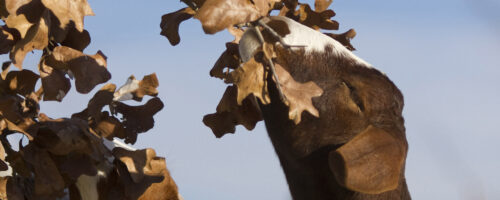Deterioration and fragmentation of bobwhite habitat are the primary causes of the bobwhite decline throughout the United States. Fragmentation is the process in which habitat elimination separates or isolates remaining areas of habitat. Recent scientific information indicates quail populations may need enough contiguous habitat to support at least 800 quail to prevent localized extinction over the long term. The area required to support 800 quail probably ranges from 800 to 8,000 acres, depending upon the quality of the habitat.
Most landowners interested in quail do not own several thousand acres of habitat, so should they give up? No, quail management is not hopeless, but it is not easy either. A landowner with a relatively small tract, such as 160 acres, should manage the tract so every bit of it, or at least as much as possible, is quail habitat. A 160-acre tract with 50 acres of oak woodlot, 60 acres of Bermuda grass, 40 acres of wheat, and 10 acres of native rangeland does not have 160 acres of quail habitat. In fact, this quarter section has very little quail habitat.
Ideal quail habitat has 10 to 60 percent woody canopy cover well distributed across the landscape, with mostly brushy woody cover rather than timber. It has no locations where quail could venture farther than 100 yards from woody cover. The herbaceous plant community is dominated by native plants rather than introduced species. More than 250 clumps of native bunch grasses exist per acre. Forbs are abundant. Canopy cover of herbaceous plants ranges from 25 to 75 percent, with most herbaceous plants 10 to 20 inches tall. Underneath the canopy of woody and herbaceous plants, 30 to 60 percent of the ground is bare (lacking plant thatch or stems). The amount of quail habitat present on a tract of land depends on how much of the land matches this description.
Quail management should primarily address cover issues, such as woody cover, herbaceous cover, and ground cover. These cover types should be managed primarily through tools such as appropriate grazing, rest, and prescribed burning. In some cases, tillage and brush control can be practical tools for managing cover as well. Quail food is generally not a limiting factor when native plant communities are managed for appropriate cover. In fact, food seldom limits quail populations. Drought, heat, snow, subfreezing temperatures, lack of adequate cover, or excessive cover usually limit quail populations. Providing quail food may attract more quail to a small area, which may be useful for hunting or observational purposes, but probably will not cause the area to produce more quail.
If a 160-acre tract exists among neighbors with adequate quantity and quality of quail habitat, well-managed habitat on the tract should provide reasonable quail numbers during years with average to good quail abundance. If the tract is an island because the neighborhood has poor quail habitat, or if low rainfall and hot temperatures cause poor quail abundance, habitat management alone on the quarter section often provides less than optimum results. To provide adequate quail abundance for hunting in this latter situation, managers may have to stock quail.
Working with neighbors to form a wildlife management association is an option to create an adequate quantity and quality of quail habitat in the neighborhood. A successful wildlife management association can be quite a challenge. The primary challenge in such an association is people management, not necessarily wildlife management. It can be difficult to convince neighbors to work together toward common goals. However, the potential rewards are great.
Hunting pressure is an important issue and should be managed on small acreages. Quail populations on relatively small tracts of land are somewhat delicate. Hunting pressure probably should not exceed twenty-eight man-hours of hunting per 100 acres during each hunting season, which is not a lot of hunting. For example, it represents one person hunting for twenty-eight hours, two people for fourteen hours, or seven people for four hours. Generally, quail harvest should not exceed 30 percent of a fall population. If this amount of hunting opportunity does not satisfy a landowner’s quail hunting goals, the wild population should be supplemented with released birds, or the landowner should pursue additional hunting opportunities elsewhere.
All released quail and all release techniques are not equal. Some commercially available quail genetics are better adapted for survival in the wild than others. Most important, quail should be raised in isolation, away from contact with humans, dogs, and the like. Isolation is important to obtain adequate performance and survival of released quail because quail domesticate relatively easily. Appropriate release techniques, such as the Anchor Covey System or Smith-O’Neall System, should be employed because they improve survival of released quail relative to some other techniques.
We are all part of a bigger picture. What we do affects others and their actions affect us. Most worthwhile goals in life require work and commitment. In summary, successful quail management on small acreages is possible, but not necessarily easy.

Comment